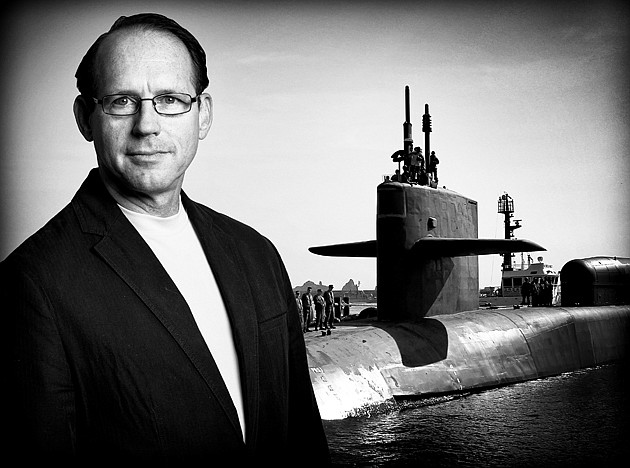David Marquet, a U.S. Navy nuclear submarine captain, was rather pleased with himself when he gave his first order on the USS Santa Fe.
The crew, down the chain of the command, followed the order precisely. Or at least they tried. Turns out Marquet, who extensively studied the inner workings of another sub, the USS Olympia, before his assignment changed, was confused about some technical aspects of the Santa Fe. So the order to move the sub in a specific direction was mechanically impossible.
Yet Marquet says “the officer did what I said, even though it made no sense.” Puzzled and embarrassed, Marquet asked the officer why he passed an order down the line he knew was impossible to carry out. The response back: Because you told me to.
Marquet says that moment, underwater in 1999 with 135 sailors on the Santa Fe, was his leadership epiphany. He knew the Santa Fe, a troubled sub with poor engineering scores and even worse re-enlistment rates, which go to poor morale, was a major turnaround task. But he decided to tackle the project with a new brand of leadership — one that values true autonomy over false empowerment, and one that creates a culture of doers, not followers.
“Everything I knew about leadership was wrong,” says Marquet. “Everything I knew about leadership was giving directions and telling people what to do. But to achieve the highest ideals, it's all about discretionary effort.”
And discretionary effort, Marquet learned, can't come from barking orders.
Marquet led the Santa Fe for three years. The fast-attack submarine, which the Navy once considered the bottom of the fleet, has since won several awards for performance. The reenlistment numbers went from three one year to 33 the next year. Marquet, moreover, is most proud of the fact that 10 Santa Fe officers have gone on to command other subs in the fleet — a rate three times greater than average.
A U.S. Naval Academy graduate, Marquet worked at the Pentagon after he left the Santa Fe. A south Sarasota County resident, Marquet also recently wrote a book about his leadership experience. The book is “Turn the Ship Around! How to Create Leadership at Every Level.” Marquet now runs a leadership consulting business, where he works with companies and executives.
Marquet recently sat down with the Business Review to talk about leadership and his experiences in the Navy.
What leadership problems did you encounter when you took over command of the Santa Fe?
One of the things I rail against is the idea of empowerment. Top-down empowerment doesn't work. A top-down leader says the reason I want to empower you is because I already disempowered you. If you treat people like followers, they act like followers. Then they lose their passion, they lose their initiative, they lose their ownership and their leader goes, what happened? Where's your passion, where's your initiative, where's your ownership? Well you've stolen it from me because you told me what do to all day long. All empowerment programs fail.
In the book, you write about emancipation over empowerment, which can unleash “the inherent genius, energy and creativity in all people.” How did you make that switch on the Santa Fe?
I stopped giving orders, and that was hard at first. Instead of saying 'I order you to submerge the ship,' an officer would say 'I intend to submerge the ship' and I would say 'very well.' This unleashed an explosion of passion and energy. Instead of one or two people thinking and the rest following, we had 135 thinkers.
We also canceled all briefs. A brief is passive. A brief is only active for the leader. What we did instead was what we called certifications. This is where the guys would come and say, 'hey we're going to submerge the ship.' A certification shows that the team is ready. Now people have to think for themselves.
What were some of the signs that the strategy was working?
When you give people authority you can get your cake and eat it, too. Because you can achieve great things in the moment. There are two ways to achieve great things in the moment. One is you can give people all this authority and get them involved. The second way is to produce great people, and produce more leaders.
How did Navy officials you report to react to what you were doing?
Basically it couldn't get any worse. We reenlisted three sailors the year before I got there out of a crew of 135. Typically you reenlist 15 to 20. We were at the bottom of the fleet. There was a tremendous call to action.
The guy before me quit. And they picked me because I was the most curious guy during the (training) class. I exhibited a lust for learning and curiosity. I didn't realize at the time that would be the key personal attribute that I had to take into the fight with me.
How can the theories you promote translate to a business setting?
You have to give people control and the ability to make decisions. The two supporting pillars to that are competence and clarity. On organizational clarity, you have to know what you are trying to achieve. Are you trying to make the most money today, or are you trying to improve a reputation?
The biggest problem with organizational clarity is companies aren't clear with themselves. If you tell your people what you're about, don't be surprised when people make decisions based on that.
What are the qualities of a successful leader?
The desire of a leader has to be to leave the organization better than when you got there. You have to have the desire to make better people around you. We have these guys who leave a company and the company falls apart and we bemoan them. I say (that leader) was a great achiever. But I'm not sure he was a great leader. Because if he was a great leader, he would have embedded the organization with a lot of great people.
Who are some leaders you admire?
There's a guy named Charlie Kim, who runs a software company in New York. He gives a tremendous amount of authority to his people. He's really doing a lot of great things. For example, they get to pick which team they are on. They get to pick which product they work on, and every six months they have the opportunity to shift teams.
There are a lot of people who want do this (kind of leadership). But the guy I hold up as the archetypical guy is George Washington. He didn't envision greatness in himself. He accomplished great things, and he won the Revolutionary War, but his greatness was actually when he stepped down. His greatness was allowing Congress to write the Constitution and the Declaration of Independence. You want a leader like that, whose highest ideals are to the principles.
 Are great leaders born or developed?
Are great leaders born or developed?
Not only are leaders not born, but most of your instincts to be a leader are taken away when you are born, with mammal instincts of social dominance and hierarchy. To be a great leader we have to have the courage to go against our instincts. It feels unnatural as a leader to be giving away control. That's why there are so few great ones. But the victory is so overwhelming.
Book It
David Marquet, a retired nuclear submarine captain who lives in south Sarasota County, recently wrote the book “Turn the Ship Around! How to Create Leadership at Every Level.” Fortune magazine, in its Nov. 12 issue, named Marquet's book its No. 1 “must-read” book of the year.
In an article written by Verne Harnish, CEO of Gazelles Inc., Fortune says Marquet's book is the “best how-to manual anywhere for managers on delegating, training and driving flawless execution.” The book has also been a top business seller on Amazon.com for several weeks.
Chutes & Ladders
David Marquet, a retired U.S. Navy nuclear submarine captain, set out to redo the traditional leadership structure when he took over the USS Santa Fe in 1999.
 One key to the turnaround was Marquet's involvement ladder. The bottom rung, “tell me what to do,” is a total leadership failure, Marquet determined. The top rung, the ultimate in leadership, when the entire unit has full autonomy, is “I've been doing.”
One key to the turnaround was Marquet's involvement ladder. The bottom rung, “tell me what to do,” is a total leadership failure, Marquet determined. The top rung, the ultimate in leadership, when the entire unit has full autonomy, is “I've been doing.”
Marquet says the 135 people on his submarine, within a year or so, consistently made their own decisions and reported back to higher-ups. They were on the “I intend to” rung. “Small changes,” says Marquet, “make a very big difference.”
Still, Marquet recognizes the changes are a challenge. “A leader must have the courage to give up control,” he says, “because the higher you get the less control you have.”
Here's a glance at the rungs on Marquet's involvement ladder.


 Are great leaders born or developed?
Are great leaders born or developed? One key to the turnaround was Marquet's involvement ladder. The bottom rung, “tell me what to do,” is a total leadership failure, Marquet determined. The top rung, the ultimate in leadership, when the entire unit has full autonomy, is “I've been doing.”
One key to the turnaround was Marquet's involvement ladder. The bottom rung, “tell me what to do,” is a total leadership failure, Marquet determined. The top rung, the ultimate in leadership, when the entire unit has full autonomy, is “I've been doing.”



